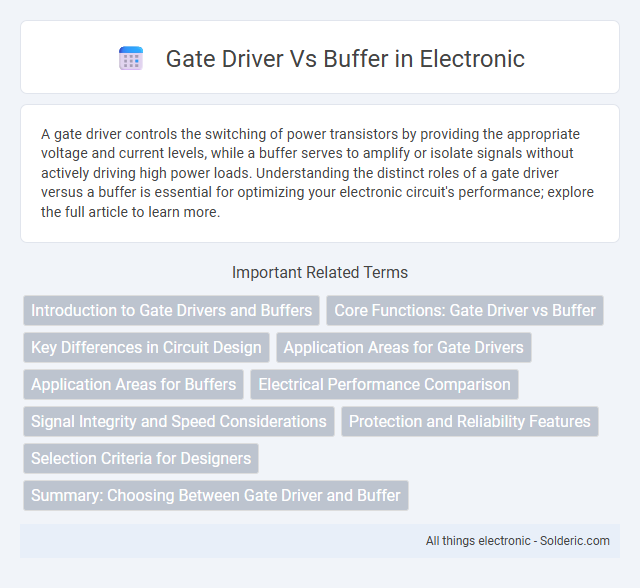A gate driver controls the switching of power transistors by providing the appropriate voltage and current levels, while a buffer serves to amplify or isolate signals without actively driving high power loads. Understanding the distinct roles of a gate driver versus a buffer is essential for optimizing your electronic circuit's performance; explore the full article to learn more.
Comparison Table
| Feature | Gate Driver | Buffer |
|---|---|---|
| Primary Function | Drives high-current gates of power transistors | Amplifies or isolates digital signals |
| Typical Application | Switching MOSFETs and IGBTs in power electronics | Logic signal conditioning and signal integrity |
| Current Capability | High output current (up to several amps) | Low to moderate output current (mA range) |
| Voltage Levels | Handles higher voltages, often up to 20-30V or more | Typically operates at logic voltage levels (3.3V, 5V) |
| Speed | Optimized for fast switching with minimal delay | Moderate speed suitable for digital logic |
| Isolation | Usually no galvanic isolation | May provide signal buffering/isolation within logic domains |
| Examples | IR2110, TC4420 | 74HC125, 74LS244 |
Introduction to Gate Drivers and Buffers
Gate drivers control the voltage and current supplied to power transistors, ensuring efficient switching performance in electronic circuits. Buffers act as intermediary devices that amplify signals to prevent signal degradation and maintain data integrity across components. Understanding the difference between gate drivers and buffers helps you optimize circuit design for speed, power efficiency, and signal stability.
Core Functions: Gate Driver vs Buffer
Gate drivers primarily function to provide the necessary voltage and current to switch power transistors efficiently, ensuring fast and reliable operation in power electronic circuits. Buffers serve to isolate input signals, stabilize logic levels, and prevent signal degradation by matching impedance without necessarily driving high current loads. While gate drivers handle high-power switching demands, buffers focus on signal integrity and conditioning within digital circuits.
Key Differences in Circuit Design
Gate drivers and buffers differ primarily in circuit design, where gate drivers are specialized to supply higher current and voltage to efficiently switch power MOSFETs or IGBTs in high-speed applications. Buffers, on the other hand, amplify signal strength or isolate input from output with simpler, low-current designs primarily for logic-level signals. Your choice depends on whether you need robust power switching (gate driver) or signal conditioning and isolation (buffer).
Application Areas for Gate Drivers
Gate drivers are essential in power electronics, controlling high-voltage MOSFETs and IGBTs in applications such as motor drives, DC-DC converters, and inverters for renewable energy systems. They provide precise voltage and current levels to switch these power devices efficiently, ensuring optimal performance and protection. Your selection of a gate driver impacts the reliability and efficiency of industrial automation, electric vehicles, and power supply units.
Application Areas for Buffers
Buffers are commonly used in digital circuits to strengthen signal integrity and drive higher loads without distortion, making them essential in applications like data communication, memory devices, and microprocessor systems. In contrast to gate drivers, which specifically control power transistors in switching applications, buffers serve broader roles such as signal delay, noise isolation, and voltage level shifting. Your designs benefit from buffers when you need to maintain signal quality across long interconnects or interface different logic families.
Electrical Performance Comparison
Gate drivers deliver precise current pulses with low output impedance, ensuring rapid switching transitions and minimizing power loss in power electronics circuits. Buffers primarily provide signal isolation and voltage level shifting but often exhibit higher propagation delay and less drive strength compared to gate drivers. Your choice should prioritize gate drivers when fast switching speed and efficient power management are critical for electrical performance.
Signal Integrity and Speed Considerations
Gate drivers enhance signal integrity by providing the necessary current to rapidly switch power transistors, reducing overshoot and ringing compared to buffers. Buffers primarily isolate and reshape signals but lack the high current drive capability essential for fast switching in power applications. Choosing a gate driver over a buffer improves the speed and reliability of your power switching circuits by minimizing signal distortion and ensuring precise timing.
Protection and Reliability Features
Gate drivers provide enhanced protection and reliability features compared to buffers by incorporating built-in safeguards such as under-voltage lockout, overcurrent protection, and thermal shutdown, which prevent damage to power transistors and circuits. Buffers primarily serve to amplify or isolate signal levels without advanced protective functions, making them less reliable in high-power or sensitive applications. Your system's durability significantly improves when using gate drivers designed to ensure safe switching and fault tolerance under varying electrical conditions.
Selection Criteria for Designers
Designers select gate drivers over buffers when high current drive capability and rapid switching of power MOSFETs or IGBTs are required to enhance efficiency in power electronics. Buffers are preferred for signal integrity improvement and impedance matching in digital circuits with moderate speed and lower output current demands. The choice depends on application-specific factors such as load capacitance, switching frequency, voltage levels, and power dissipation constraints.
Summary: Choosing Between Gate Driver and Buffer
Gate drivers specialize in controlling high-power semiconductor devices with efficient voltage and current amplification, essential for switching applications in power electronics. Buffers primarily provide signal isolation and impedance matching to prevent signal degradation in digital circuits. Selecting between them depends on application needs: gate drivers suit power switching with precise control, while buffers are ideal for signal integrity in logic level management.
gate driver vs buffer Infographic

 solderic.com
solderic.com